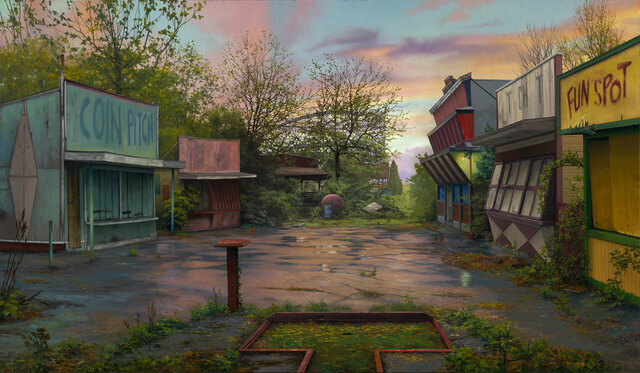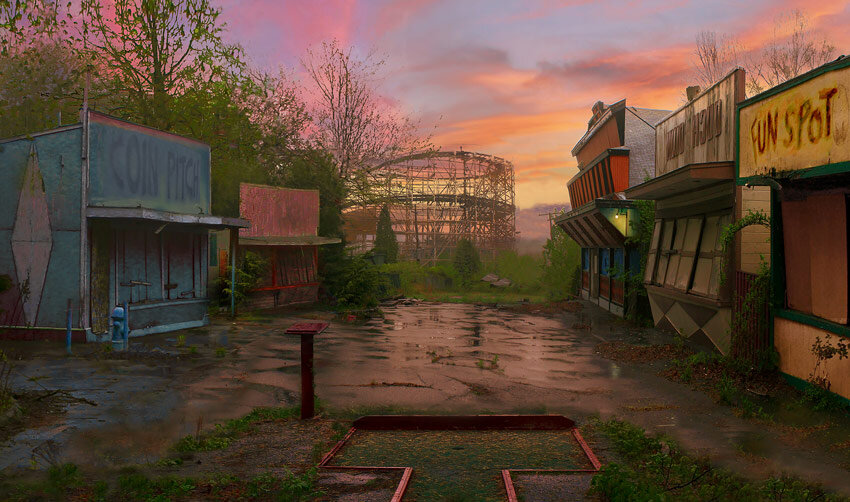Scott Prior at his easel. Photo courtesy of Dan Treeger
In the third installment of Artist Insights, American realist painter Scott Prior reflects on Abandoned Amusement Park.
My painting “Abandoned Amusement Park” is about many things. Above all it is about the changes brought about by the passage of time. This subject is of common interest among writers, composers and artists. There are many art historical precedents for my painting. During the Romantic Era in Europe, poets and painters sought lessons from the ravages of time.
Caspar David Friedrich, Eldena Ruin, ca. 1825
Caspar David Friedrich, a German painter in the early 1800’s, painted the ruins of churches and monasteries, such his painting of the ruins of Eldena Abbey of 1825 in the Alte Nationalgalerie in Berlin. Later on, painters such as Corot painted the remnants and ruins of Ancient Rome. On a less esoteric level, my painting is also about my quest to create compositional and color balance in landscapes. Here I attempted to create an enclosed “room” in nature.
I have lived long enough to see many things that once were, along with my youth, disappear. When I paint landscapes I am aware of the human presence, even if there are no people in the paintings. I feel that my early appreciation of Edward Hopper is responsible for this. I once did a series of etchings called “Off Season.” “Ball in Winter” is an example. In the forward to the series I wrote:
Scott Prior, Ball in Winter, 2005, hand drawn and printed lithograph, 18 x 13 in.
“There are conditions of time and place that may be characterized as off-season: the slow months at tourist areas, winter at the seashore, the lake after Labor Day. At such places, when we are alone and it is quiet, a window that is usually closed opens within us. We are reminded of the mortality of things and the passage of time. Our thoughts are more poignant because we know the awareness is temporary. Soon the winter will become summer, and we will return to the main road after our detour.
For a moment it seemed that the battle between Nature and Man was not already won…Some grass had broken the concrete. But Nature does not boast, and it has impressed us with its strength and humility.”
I wrote this nearly 35 years ago and it still seems appropriate for the understanding of my current landscapes.
As with most of my paintings there is a personal story behind “Abandoned Amusement Park.” The place is the former Whalom Park in Lunenburg, Massachusetts. It was built in 1893 as a trolley park. At that time rail connections were built by trolley and railroad companies to bring city dwellers to healthy country destinations. They are all pretty much gone now. Before they began to disappear I photographed and painted them, once again when they were uninhabited, off season. A decade or two later I took a side trip and saw that the park was closed and going to ruin. I returned a few days later, at day break, so that I would not be noticed climbing over the enclosing chain link fence. It was early spring and the trees had just begun to turn green. There had just been a light rain. I hurriedly took many photographs, fearing that I would be detected and kicked out. When I climbed back over the fence I knew that I had some very good material for a future painting or two.
I worked for a long time collaging the photos in Photoshop, bringing in additional photos from other sessions. When I am satisfied with the working photo, I begin the painting, attempting to get it right with the first layer of paint. I work in small segments, much the way the painters of the Renaissance created their wall and ceiling frescos.
In the case of “Abandoned Amusement Park” I made one major change, months after I thought it was finished: I covered the distant roller coaster with spring foliage. The roller coaster was a lot of work for me, but the change enclosed the foreground space, to better create the sense of a “room” in the painting. One last point of note. I added a dim bluish light on the right side of the painting. I believe I did this to indicate one last remnant of a living presence of humankind, amidst its destruction.
As an added bonus, watch Scott Prior put the finishing touches on Abandoned Amusement Park below!







